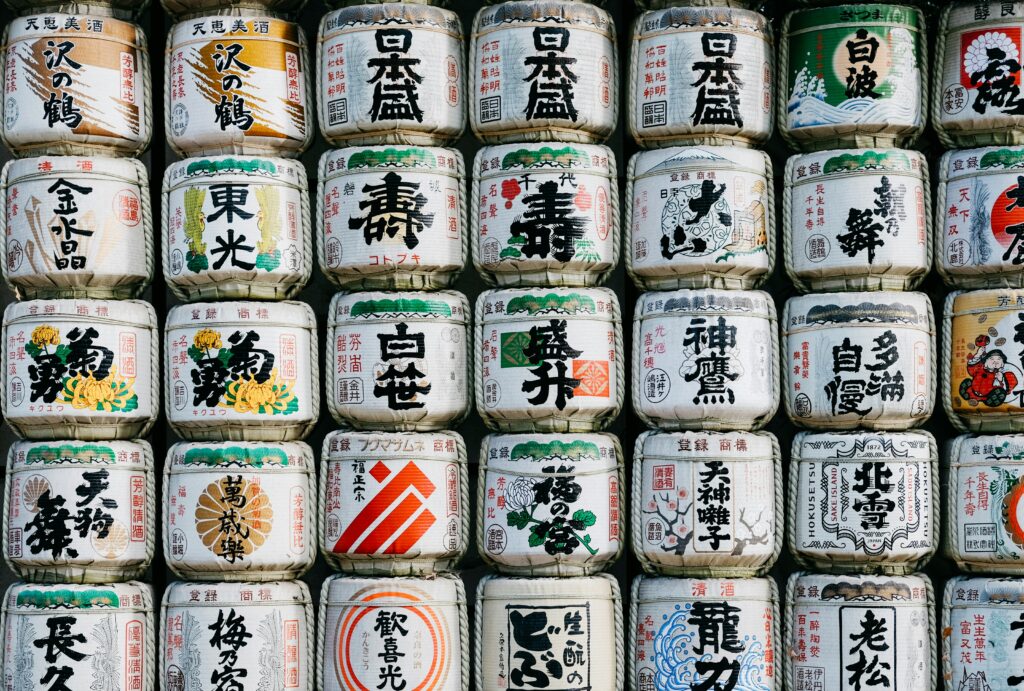Sake is a traditional Japanese alcoholic beverage known for its flavorful taste and unique production process. Its origins are rooted in ancient history and rice farming culture. Sake is also an indispensable part of Japanese culture, with sake offered as an offering at festivals held at shrines, and sake served at weddings and other celebratory occasions. In recent years, sake has become increasingly popular overseas under the name ‘SAKE’ and is widely accepted around the world.
Sake in Myth
Sake is considered to be the oldest sake made from rice, as described in the ‘Osumi no kuni fudoki (大隅国風土記)’. Sake is made by chewing heated rice in the mouth, saccharifying it with enzymes contained in saliva, and fermenting it with wild yeast. The practice of mouth-biting was restricted to shrine maidens only.
The origin of sake brewing is mentioned in the ‘Kojiki (古事記)’ and Nihonshoki (日本書紀)’. The “first sake made in Japan,” according to myth, was ‘yashiori no sake (八塩折之酒),’ which was made by Susano-no-mikoto to defeat the eight-forked serpent. However, it is said that the ingredients of Yashiori no sake may have been nuts or fruits, rather than rice.
The Harimanokuni Fudoki, compiled in the early Nara period (710-794), states that the rice offered to a great deity grew mold, so sake was made and offered to the deity. The direct connection between the moldy rice and the making of sake leads us to believe that sake brewing using the prototype of rice malt was already widespread.
Shoryakuji Temple, the birthplace of Japanese sake
The Muromachi period sake brewing chronicle ‘Goshu no Nikki (御酒之日記)’ includes a section titled ‘Bodai sen (菩提泉)’ that describes in detail the sake brewing methods used at Shoryakuji Temple. The Tamonin Nikki (多聞院日記), written by a monk of Kofukuji Temple from the end of the Muromachi period, also mentions sake brewing at Shoryakuji Temple. The ‘Morohaku Zukuri (諸白づくり)’ method developed at Shoryakuji is considered to be the prototype of Japanese sake.
It seems to have been actively produced from around the Kakitsu (嘉吉) period (1441-1444) of the Muromachi period. The sake produced at Shoryakuji Temple is called ‘Mujo-shu (無上酒, sake with no top quality)’, and Ashikaga Yoshinao, the ninth shogun of the Muromachi Shogunate, is said to have praised it highly, saying, “It is the best sake”.
The process developed at Shorakuji Temple is considered to be the ancestor of the modern sake brewing process. In 1999, the “Bodai-moto” method developed in the Muromachi period was restored for the first time in about 500 years, and several sake breweries in the prefecture now produce Bodai-moto sake.

Development and Diversity of Sake Culture
In the Edo period, sake brewing techniques were further advanced, and sake culture developed along with the prosperity of Edo. During this period, many sake breweries and taverns appeared, and sake was enjoyed as a form of socializing and entertainment. The Edo period also saw the emergence of new sake brewing techniques, which further increased the diversity of sake. Sake, like soy sauce and miso, came to occupy an important position as a traditional Japanese condiment.
With the rapid modernization of Japan after the Meiji period, sake brewing techniques changed and the production process was modernized. In addition, during the Showa period , sake was exported, and international recognition of sake expanded. In recent years, sake has gained a high reputation worldwide and is enjoyed outside Japan as a part of Japanese culture.
In recent years, not only has sake been highly acclaimed at international sake competitions, but there has also been a movement to brew SAKE locally. In New York, the United States, craft bars that brew SAKE are gaining popularity, and new SAKE products are being made with an emphasis on rice and water produced in the United States. In France, SAKE is being made with a special attention to detail, incorporating wine-making methods.

Continuing to evolve with the times
Sake has a long and deep history and continues to attract people of all ages and races. Sake continues to evolve with the times, incorporating new techniques and approaches. With its unique history and climate as a backdrop, sake will continue to take on new challenges into the future.

